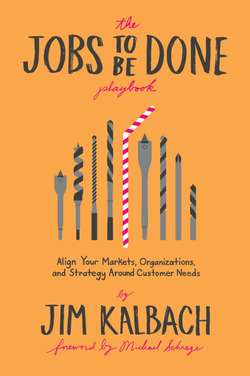Читать книгу The Jobs To Be Done Playbook - Jim Kalbach - Страница 15
На сайте Литреса книга снята с продажи.
Perspectives of JTBD
ОглавлениеDespite some common terminology and desired end results, the field of JTBD has unfortunately split into different schools of thought. Newcomers to JTBD may find an array of approaches and opinions on the topic, leading to confusion and discouragement. Contentious debates exacerbate the divide.
JTBD falls broadly into two camps. On the one side, there is the so-called “Switch” school of thought, pioneered by Bob Moesta. Through qualitative interviews, the Switch technique seeks to reverse engineer the underlying motivation for changing from one solution to another. The researcher can then deduce why people “hire” a solution to get a job done and analyze the forces of change. The aim is to increase demand for a given product or service.
On the other side is Tony Ulwick’s Outcome-Driven Innovation (ODI), a strategy and innovation approach focused on pinpointing customer-centered opportunities. In qualitative interviews, ODI uncovers all of the desired outcomes that people want from getting a job done in a given domain. In a separate step, these desired outcomes are prioritized with a quantitative survey. ODI increases the adoption of innovation by creating products that address unmet needs.
MILKSHAKE MARKETING REVISITED
Harvard Business School professor Clayton Christensen often frames JTBD with a story involving milkshakes. He and his team were reportedly working with McDonald’s to understand how to improve milkshake sales. Previously, the fast-food chain had tried changes to their milkshakes—making them thicker, chunkier, fruitier, etc. They also segmented consumers by demographics (e.g., age group) and tried to match those categories to different product variations. Milkshake sales did not improve.
Christensen’s team took a different approach. Instead of focusing on product attributes, they went looking for the job to be done. Why do people “hire” milkshakes?
To start, they stood in a restaurant’s parking lot and observed people getting milkshakes. Surprisingly, they learned that many people buy milkshakes in the morning on their way to work. The team dug deeper and asked people why.
It turned out that some people wanted to avoid getting hungry later in the morning. Having a snack on the drive to work helped fill them up, and milkshakes got that job done better than other options. Bananas were messy, bagels too hard to eat, a Snickers bar was unhealthy, and so on.
As a result of this story, the term “milkshake marketing” has come to refer to this type of reframing. It’s a shift in traditional marketing approaches typically centered on demographic segmentation. Instead, Christensen advises, focus on why people “hire” products and services to get a job done.
Though widely cited, the milkshake example comes with several issues. First, the starting point is an existing solution—a milkshake—and thus frames the market a priori. Focusing instead on the job, the problem might be better cast as get breakfast on the go.
Second, milkshake sales, in fact, did not improve as a result of this study. Of course, there were many potential variables and reasons why the fast food chain didn’t follow the advice of Christensen’s team. But it was not a success story per se. (Personally, I don’t know why McDonald’s doesn’t offer a low-sugar protein breakfast shake based on this insight).
You’ll likely come across the milkshake story in your exploration of JTBD. Just be aware that, while popular and widespread, the example has limitations in applying JTBD. The focus of the story is on demand generation of an existing product (buying a milkshake) not on understanding the underlying objective (getting breakfast on the go).
I believe these two sides are not mutually exclusive, and there is a place for both. Sometimes, it makes sense to understand people’s objectives and needs from the bottom-up (i.e., ODI), for instance, when developing a new product or when redefining your market. Other times, it’s appropriate to start with a particular product in mind and understand why people “hired” that product to get a job done (i.e., Switch).
In the end, techniques from both interpretations can help your organization shift its mindset from inside-out to outside-in. There is a common focus on the underlying objectives that people have, independent of a solution. Ultimately, your goal is to make products people want, as well as make people want your products.
To be transparent, my approach is a loose interpretation of ODI, but it is not presented here as practiced by Ulwick’s firm Strategyn. I’ve also practiced Switch techniques, and I follow the work of Bob Moesta closely. In working with both approaches, I have found a growing group of practitioners who benefit from a wide variety of JTBD techniques. This book strives to bring both perspectives together under one broad practice of JTBD.
Overall, JTBD is not a single method: it’s a lens, a way of seeing. JTBD lets you step back from your business and understand the objectives of the people you serve. To innovate, don’t ask customers about their preferences, but instead understand their underlying intent. Ultimately, JTBD seeks to reduce the inherent risk in innovation and ensure product-market fit from the outset.
There are many techniques that fall under the JTBD umbrella, and we’ll look at many of the more popular ones that have surfaced over the past three decades throughout this book.
